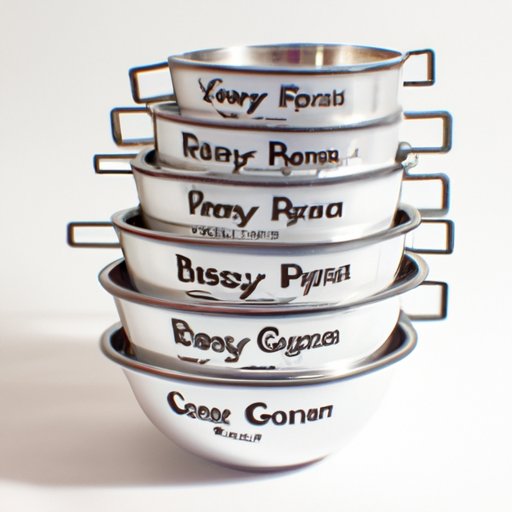Introduction
Baking and cooking are excellent hobbies that give people immense joy, however, it can be quite confusing when you have to convert measurements while following a recipe. The icing on the cake is when you see a recipe that is listed in cups, especially if you’re much more comfortable with the metric system where everything is measured by weight, such as in kilograms or pounds. In this guide, we will help you eliminate the guesswork with a simplified and comprehensive guide to convert cups to pounds.
The Ultimate Guide to Converting Cups to Pounds: How Much Do You Really Need?
Knowing how many cups are in a pound is essential because using the right amount of ingredients can make or break a dish. It is vital to keep the exact measurements, especially in recipes that involve baking. Without perfect measurements, your baking goods may not rise, and the outcome will be disappointing.
The conversion for cups to pounds will depend on the ingredient’s density. Essentially, one pound equals to 16 ounces, or 453.59 grams. To put this into context, one cup of granulated sugar weighs roughly 7.05 ounces, which is equivalent to 0.44 pounds. On the other hand, a cup of wheat flour weighs about 4.5 ounces, or 0.28 pounds.
Here are other examples of various ingredients that you might encounter in your recipes:
- 1 cup of milk weighs roughly 8.35 ounces or 0.52 pounds
- 1 cup of butter weighs approximately 8 ounces or 0.5 pounds
- 1 cup of honey weighs approximately 12 ounces, or 0.75 pounds
As you can see, using the right amount of ingredients is essential. You can adjust the recipe’s measurements to your preferences by understanding the weight of ingredients, especially when you’re baking, wherein precision is of paramount importance.
From Flour to Sugar: A Comprehensive Conversion Chart for Cups to Pounds
Here is a detailed chart to help you quickly convert the cups of ingredients to pounds.
| Ingredient | 1 cup of | Approximate weight in ounces | Approximate weight in pounds |
|---|---|---|---|
| Flour | 1 cup | 4.5 oz | 0.28 lb |
| Sugar (granulated) | 1 cup | 7.05 oz | 0.44 lb |
| Brown Sugar (packed) | 1 cup | 7.5 oz | 0.47 lb |
| Honey | 1 cup | 12 oz | 0.75 lb |
| Powdered Sugar | 1 cup | 3.75 oz | 0.23 lb |
It’s crucial to be precise in measuring ingredients when cooking or baking. Your recipe outcome will surely taste better if you stick to the exact measurement of ingredients, instead of relying on guesswork or eyeballing it. Always use measurement tools that are designed for the recipe’s needed amount, whether it’s measuring cups, measuring spoons, or kitchen scales.
Maximizing Your Ingredients: Understanding How Much of Each Ingredient You Need
When it comes to food measurements, using weight gives you a more precise number than volume (cups). Professional bakers always recommend weighing ingredients instead of using measuring cups for milk, flour, and sugar. This technique is to make sure that there are no discrepancies in the final outcome, where using the weight of the ingredients guarantees your baking’s accuracy.
Here are tips to measure cups to pounds for different ingredients:
- When measuring flour, loosen up the flour lightly by scooping it with a spoon, then put it in a measuring cup and level the surface with a flat object to obtain the exact weight measurement.
- If you’re measuring sugar, use a spoon to scoop sugar into a measuring cup and level the surface with a flat object.
- When measuring liquids, place your measuring cup on a stable surface, then pour in the liquid until it reaches the desired level.
Weighing In: How Your Cooking Could Benefit from a Kitchen Scale
Kitchen scales are handy tools for measuring ingredients accurately. Volume measurements can be complicated and cause messy outcomes unless you have the perfect measuring tools. Kitchen scales do more than merely measure the weight of your ingredient for you, they eliminate the guesswork and eliminate the need to clean the hard-to-clean cups. Moreover, kitchen scales help you save time during the preparation process, allowing you to enjoy cooking even more.
Here are some tips on how to use a kitchen scale to ensure proper measurements:
- Place measuring containers on the scale first, so you’re only weighing the ingredient. And not the additional weight of the container.
- When weighing, be sure to add ingredients slowly and gradually, so you reach the needed amount without going overboard.
- Be sure to reset your scale between measurements, particularly if you’re weighing various ingredients.
The Baking Equation: Mastering the Ideal Cup-to-Pound Ratio
When it comes to baking, the cup-to-pound ratios can significantly affect how a dish turns out. For instance, if you’re baking bread, which requires a combination of flour, water, salt, and yeast, as well as eggs, sugar, and butter, the wrong measurements can dramatically alter how the bread will turn out. Baking is a science, and you must have the right balance of ingredients to get the perfect results.
Here are some tips to find the perfect balance for your favorite recipes:
- Consult various recipes for inspiration.
- Consult multiple conversions to get the most accurate reading possible.
- Experiment with different ratios and stick to a few favorites that are tried and tested.
Conclusion
Converting cups to pounds isn’t always easy, but it’s completely achievable with the right tools and techniques. By using the conversion chart and tips provided in this guide, you can now prepare your recipes with ease and precision.
Remember, achieving the perfect measurement is a basic but crucial step in achieving a great outcome. Hence, it’s essential always to weigh your ingredients accurately, especially in baking where accuracy matters most.
Use this guide as a reference to help you explore the world of cooking and baking with a newfound appreciation for more precise measurements.
